PORT HARDY—A mid-air collision over Port Hardy Airport was the scenario Sunday as 125 emergency responders from across the Tri-Port region came together to tackle a simulated disaster.
According to the scenario, a Cessna had collided with a commercial passenger plane, pitching the smaller aircraft into the ocean and leaving dozens of injured passengers inside wreckage peppered with burning debris on the runway.
"I'm thrilled with the way the day went," said Regional District Emergency Coordinator Gloria Le Gal. She said the simulation wasn't so much a test of local personnel, rather an exercise bringing several departments together to practice a large-scale response and coordination with other departments.
The biennial event was hosted this year by Port Hardy Airport, with a school bus serving as the remains of a fuselage and about three dozen Junior Canadian Rangers playing the role of victims. Their performances were enhanced by healthy doses of special effects: fake blood, latex wounds, tinfoil shrapnel and makeup applied by George Ewald and his team.
Port Hardy Firefighters were first on the scene, tackling the blazing debris on the runway. They were joined soon after on the runway by colleagues from Port McNeill and Port Alice, RCMP members and paramedics from BC Ambulance while airport officials and emergency coordinators oversaw the operation.
Overhead, a Search and Rescue aircraft circled before dropping a pair of SAR techs on the runway and coming in to land. On the water the Coast Guard joined the operation while the hospitals ran their own parallel exercises. The Salvation Army set up in the airport to provide lunch for the participants.
After subduing the fires, firefighters escorted the walking wounded to waiting paramedics and began stretchering out the more seriously injured. Paramedics then began triage, assessing each victim and grouping the survivors by need.
Impressively, it took less than an hour and half from the first truck's arrival to extinguish all the fires, access the 'fuselage', rescue all the injured, assess their wounds and transport them off-site.
Le Gal said those involved in the simulation will meet this week to discuss the exercise. "We've all found weaknesses," she said. "We'll have a debrief next week — we've all learned something (from the exercise)."
